Posts Tagged ‘Gupta empire’
Extraordinary temple complex in Mahabalipuram and its “Descent of the Ganges”
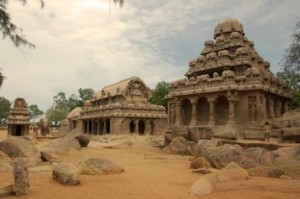 After the collapse of the late VII-VIII centuries, the Gupta empire in India formed numerous states and principalities. In the south-eastern part of the country the leading role passed to a prosperous state, Pal-lava. Here the great construction created an amazing temple complex in Mahabalipuram near Madras.
After the collapse of the late VII-VIII centuries, the Gupta empire in India formed numerous states and principalities. In the south-eastern part of the country the leading role passed to a prosperous state, Pal-lava. Here the great construction created an amazing temple complex in Mahabalipuram near Madras.
Mahabalipuram was built during the reign of Narasimhan havarmane-I (640-674) dynasty of the Pallavas, also known under the name of Mahmalla. Located on the seacoast, among the sand dunes and cliffs, Mahabalipuram temples are extraordinary, as if this architectural complex emerged by magic. It includes the central coastal temple, five small rock Rath temples, a complex of cave temples and impressive carvings known under the name of “Descent of the Ganges”, which is quite unique among the world art. Beachfront Mahabalipuram temple is the center of the sanctuary. It is a high-relief ShikharTower, a pyramid-shaped, rising on a square platform with a pedestal-going around the gallery. Visible far from the sea, it was even in the VII century equipped with navigation lights, which helped the fishermen and sailors to find their way in the night sea. The temple walls support the statues of the sacred bull Nandi, dedicated to Lord Shiva. The lobby and the tiny intermediate premise are adjacent to the main tower. Through the intermediate premise it is possible to get in a big hall used for ceremonies and supported by the strong colonnade. Paved courtyard of the temple is surrounded by stonewall, on which everybody can see the sacred bulls. Many sculptures of the temple, including the number of its interior decoration, were destroyed, and the reason is not the war but the humid marine climate.
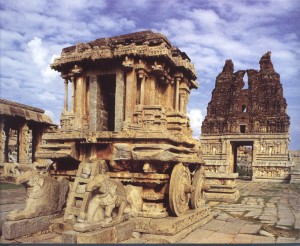 Small temples-ratha are named after gods and epic heroes: Arjuna-ratha, Dharmaraja-ratha, Bheema-ratha, Sahadeva, and Ganesha Ratha-ratha, which was dedicated to the elephant-legged god Ganesha. Rathas were entirely carved out of solid rock with a thoroughness characteristic of sculptural works. The height of the largest of them does not exceed 14 meters. In most cases the inner premises are absent. All five Rathes are different from each other, and in the appearance of each Ratha captured a type of Indian temples that existed at the time. Thus, Rathas of Mahabalipuram are like mini-encyclopedia of Indian architecture.
Small temples-ratha are named after gods and epic heroes: Arjuna-ratha, Dharmaraja-ratha, Bheema-ratha, Sahadeva, and Ganesha Ratha-ratha, which was dedicated to the elephant-legged god Ganesha. Rathas were entirely carved out of solid rock with a thoroughness characteristic of sculptural works. The height of the largest of them does not exceed 14 meters. In most cases the inner premises are absent. All five Rathes are different from each other, and in the appearance of each Ratha captured a type of Indian temples that existed at the time. Thus, Rathas of Mahabalipuram are like mini-encyclopedia of Indian architecture.
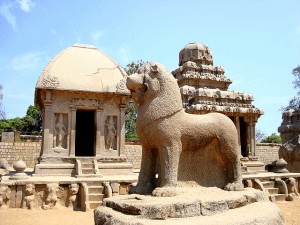 The smallest ratha – Arjuna ratha– is a massive square building with the completion of a dome beveled on all four sides. It is sometimes also called “home ascetic.” Bheema-ratha is a tiered structure with a barrel-like vault. It is rectangular as well, and surrounded by a colonnade. Its appearance looks like Sahadeva-ratha, but it has a lot of decreasing consecutive stages, simulating floors. According to the plan Dahrmaradzha-ratha is a big, square construction, completed by high pyramidal superstructure. This resembles a lot the simple models of “real” Indian temples from different areas, but nevertheless, Ratha Mahabalipuram has an independent meaning and is a real treasure of architecture and decorative art. Sometimes Ratha Mahabalipuram is compared with precious carved boxes. The five rathams are jointed by huge pieces of sacred animals carved from the rock. They are associated with the cult of the god Shiva: elephant, lion, bull.
The smallest ratha – Arjuna ratha– is a massive square building with the completion of a dome beveled on all four sides. It is sometimes also called “home ascetic.” Bheema-ratha is a tiered structure with a barrel-like vault. It is rectangular as well, and surrounded by a colonnade. Its appearance looks like Sahadeva-ratha, but it has a lot of decreasing consecutive stages, simulating floors. According to the plan Dahrmaradzha-ratha is a big, square construction, completed by high pyramidal superstructure. This resembles a lot the simple models of “real” Indian temples from different areas, but nevertheless, Ratha Mahabalipuram has an independent meaning and is a real treasure of architecture and decorative art. Sometimes Ratha Mahabalipuram is compared with precious carved boxes. The five rathams are jointed by huge pieces of sacred animals carved from the rock. They are associated with the cult of the god Shiva: elephant, lion, bull.
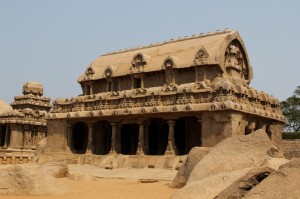 Cave temples of Mahabalipuram are also dedicated to Lord Shiva. Dimensions cave temples do not exceed 8 meters in width and depth. They are considered to be representative of Indian architectural structures of this kind and are carved into the rock hall with small portico in the form of terraces, carefully crafted and decorated by carvings and sculptures. Columns are decorated with sculptures in the form of seated lions. The main elements of these sanctuaries are niches with large multi-figure reliefs on themes of Brahmanic mythology. Among the cave temples there are the so-called Cave Pandava brothers (“Pancha-Pandava Mandapa”) with great relief depicting the god Krishna and a temple dedicated to Shiva Trimurti figures. One of the earliest cave temples is called Krishna Mantaparam. Its reliefs are telling the story of how Krishna lifted the Mount of Govardhan in order to save from Varuna, the god of rain.
Cave temples of Mahabalipuram are also dedicated to Lord Shiva. Dimensions cave temples do not exceed 8 meters in width and depth. They are considered to be representative of Indian architectural structures of this kind and are carved into the rock hall with small portico in the form of terraces, carefully crafted and decorated by carvings and sculptures. Columns are decorated with sculptures in the form of seated lions. The main elements of these sanctuaries are niches with large multi-figure reliefs on themes of Brahmanic mythology. Among the cave temples there are the so-called Cave Pandava brothers (“Pancha-Pandava Mandapa”) with great relief depicting the god Krishna and a temple dedicated to Shiva Trimurti figures. One of the earliest cave temples is called Krishna Mantaparam. Its reliefs are telling the story of how Krishna lifted the Mount of Govardhan in order to save from Varuna, the god of rain.
 Unsurpassed masterpiece of medieval Indian art is the immense relief “Descent of the Ganges.” Its length is 27 meters, height – 9 meters. Carved from pink granite, located right in the open air, in the main complex square, it seems to have been designed for large celebrations and rituals.
Unsurpassed masterpiece of medieval Indian art is the immense relief “Descent of the Ganges.” Its length is 27 meters, height – 9 meters. Carved from pink granite, located right in the open air, in the main complex square, it seems to have been designed for large celebrations and rituals.
 The center of the relief is a cleft. From this place during the ceremonies the water was flowing through the specially constructed waterfall system. This water symbolized the sacred waters of the Gang. Water, so necessary for the welfare of the inhabitants of tropical countries, is subject to public worship. It is directed at by many figures of living creatures depicted in reliefs. Unity gathered the representatives of the “upper” and “lower” areas of the world. Everything directed toward the water: heavenly beings, devas, divine musicians Gandharva, water spirits – the huge, writhing serpent-naga, the brahmin priest and wise men; nobles dressed in robes, monks-ascetics and ordinary people, carrying the water in vessels on their shoulders, animals and birds. The vast multi-figure panorama is overflown by innumerable kinds of living beings, celestial neighbors with the earth, the mythic intertwines with reality. Under flying celestial beings, devas and Gandharvas, there are the monumental sculptures of life-size figures of elephants and elephant calves. Here there are purely domestic scenes: ascetic priests are praying at the wall of a small sanctuary or women, who are milking buffaloes. The entire composition is blessed by God Shiva, the figure is depicted on the left of the cleft.
The center of the relief is a cleft. From this place during the ceremonies the water was flowing through the specially constructed waterfall system. This water symbolized the sacred waters of the Gang. Water, so necessary for the welfare of the inhabitants of tropical countries, is subject to public worship. It is directed at by many figures of living creatures depicted in reliefs. Unity gathered the representatives of the “upper” and “lower” areas of the world. Everything directed toward the water: heavenly beings, devas, divine musicians Gandharva, water spirits – the huge, writhing serpent-naga, the brahmin priest and wise men; nobles dressed in robes, monks-ascetics and ordinary people, carrying the water in vessels on their shoulders, animals and birds. The vast multi-figure panorama is overflown by innumerable kinds of living beings, celestial neighbors with the earth, the mythic intertwines with reality. Under flying celestial beings, devas and Gandharvas, there are the monumental sculptures of life-size figures of elephants and elephant calves. Here there are purely domestic scenes: ascetic priests are praying at the wall of a small sanctuary or women, who are milking buffaloes. The entire composition is blessed by God Shiva, the figure is depicted on the left of the cleft.
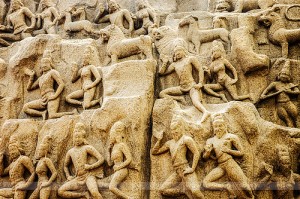 The relief “Descent of the Gang” in Mahabalipuram has played a huge role in the art of India and neighboring countries. Its motives are clearly seen in many Indian dwellings, in the reliefs of Indonesian Borough Badoureau and in temples of Central Java and Ceylon.
The relief “Descent of the Gang” in Mahabalipuram has played a huge role in the art of India and neighboring countries. Its motives are clearly seen in many Indian dwellings, in the reliefs of Indonesian Borough Badoureau and in temples of Central Java and Ceylon.
On the shore of the Bay of Bengal in the Indian state of Orissa there are majestic, extremely impressive ruins of the temple of the ancient Hindu god Surya, the god of Sun. It is considered to be one of the largest temples in India. For a long time the European called it the “Black Pagoda”. This stone colossus climbing alone on the desert shore served as a guide to them in their numerous trips.
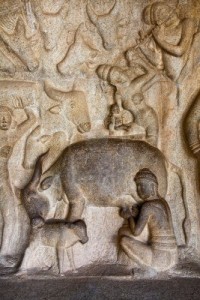 Surya temple of Konarak was built by the governor of Orissa the Raja Narasimhadeva I in XIII century. This is one of the last and largest buildings in honor of the god of sun.
Surya temple of Konarak was built by the governor of Orissa the Raja Narasimhadeva I in XIII century. This is one of the last and largest buildings in honor of the god of sun.
Orissa ruler Raja Narasimhadeva I (1238-1264) from the Gang dynasty made a series of successful wars, as a result of them he conquered the neighboring states, after that he began to raise funds for a grand building, which was intended to Rajah the mercy of the gods and the prosperity of the state. On the construction of the church it was spent not only the war booty, but the tribute of vassal princes and the gifts of Raja’s relatives.
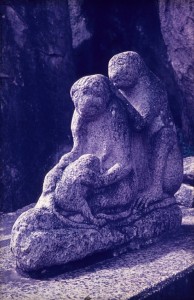 The area, chosen for the construction of the temple, had been held sacred for a long time and also it was associated with the cult of the Sun. The very name of Konarak – “Con-Ark” – means “Land of sunlight.” The construction of the temple began in a “favorable” the fifth year of the Raja government and lasted for about eighteen years. Stone for the construction – granite, basalt, sandstone of various shades – was brought by water from three distant quarries.
The area, chosen for the construction of the temple, had been held sacred for a long time and also it was associated with the cult of the Sun. The very name of Konarak – “Con-Ark” – means “Land of sunlight.” The construction of the temple began in a “favorable” the fifth year of the Raja government and lasted for about eighteen years. Stone for the construction – granite, basalt, sandstone of various shades – was brought by water from three distant quarries.
Fantastic building the temple of the sun was once graced by the tower of 60 meters high. It was name like Shikhar. Today it resembles a heap of ruins. From two parts of the sanctuary only the eastern part was remained. It is the building of the Hall of Columns, where there is the entrance to the temple itself. The main part of the sanctuary tower Shikhar, was destroyed either by a natural disaster, or as the result of the raids of the Muslims in the middle of the XVI century. The fact that the destruction of the temple was caused by some hostile forces, is mentioned in the temple record.
Ajanta caves – impressive monuments of the ancient Indian art
 One of the most outstanding monuments of the ancient Indian art is a complex of cave temples of Ajanta. It was created in the era of the Gupta empire – the last major state of ancient India, uniting in 320 northern and central parts of the country.
One of the most outstanding monuments of the ancient Indian art is a complex of cave temples of Ajanta. It was created in the era of the Gupta empire – the last major state of ancient India, uniting in 320 northern and central parts of the country.
Underground complex of Buddhist temples of Ajanta was being built up over the centuries, in 200 – 650 years. It is a series of caves carved into the rocks and connected by the wide trail. Five caves are temples (viharas), the rest twenty-four are monastic cells (Chaiten). Typical Ajanta cave temple consists of a large square hall with small monastic cells arranged around it. On each side of the room, there are side passages which are separated by colonnades. They were built for religious processions. Ceilings of caves support the carved columns or covered with paintings. Besides it the carved columns decorate the entrances to the caves.
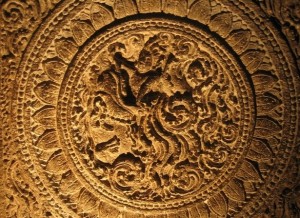 Ajanta became famous because of its remarkable paintings. They have survived only because of the remoteness and solitude of the temple complex, while the other ancient temples were destroyed by religious fanatics. But another enemy of the ancient murals have become the time and climate. As a result, only thirteen of the thirty-nine caves have preserved fragments of ancient art.
Ajanta became famous because of its remarkable paintings. They have survived only because of the remoteness and solitude of the temple complex, while the other ancient temples were destroyed by religious fanatics. But another enemy of the ancient murals have become the time and climate. As a result, only thirteen of the thirty-nine caves have preserved fragments of ancient art.
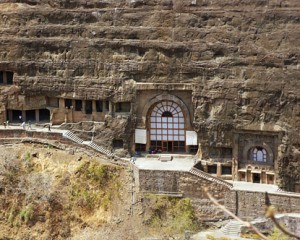 Ajanta paintings are a kind of encyclopedia of life in India for the entire historical period of V-VII centuries. Most paintings of Ajanta are the illustrations of the Buddhist legends. However, along with a strictly canonical images of the Buddha and saint bodhisattvas, there are many images that are not related to the canons. They show the scenes from the life of ancient India with amazing vigor and honesty. This is explained by the fact that the painting of the cave temples of Ajanta had a profound impact to the existing up to the present day paintings that once decorated the palaces of kings, nobles and other representatives of high society.
Ajanta paintings are a kind of encyclopedia of life in India for the entire historical period of V-VII centuries. Most paintings of Ajanta are the illustrations of the Buddhist legends. However, along with a strictly canonical images of the Buddha and saint bodhisattvas, there are many images that are not related to the canons. They show the scenes from the life of ancient India with amazing vigor and honesty. This is explained by the fact that the painting of the cave temples of Ajanta had a profound impact to the existing up to the present day paintings that once decorated the palaces of kings, nobles and other representatives of high society.
At the same time in many subjects of the Ajanta paintings there are the scenes of court life: princes are spending time in their luxury apartments, surrounded by wives and maids, or they are going to war or hunting, or taking guests. These images allow to reconstruct easily the urban architecture of India of that time. In most cases it was made of the wood: the palaces, houses of wealthy citizens, the gates, everything. Unfortunately all has been lost and nowadays we haven’t had any real samples.
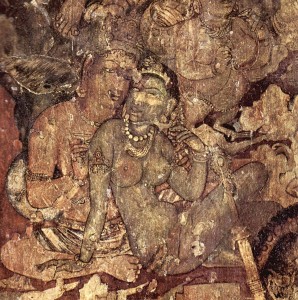
 Ajanta paintings were created over the centuries by generations of artists, so we can find their expression in many art features, trends and styles of ancient India. Volumes of these paintings are really striking: for example, in one of the underground rooms painting takes more than a thousand square meters, and it was painted not only on the walls, but on the columns and ceilings as well. And it was inside all twenty-nine caves. We have the feeling as if Indian masters were trying to move the variety and the richness of the outside world to close cave environment. They generously filled the walls and ceilings of caves by images of trees, animals and people. They were trying to fill every inch of the surface by the painting. And for over a thousand years on the walls of the dark caves there have been fussy little monkeys, bright blue peacocks, lions and fantastic fairy creature with a human torso, animal tails and bird leg. Many centuries ago they were illuminated with fire lamps and torches. Only bizarre rocks and trees know about their lives. The human world and the world of heavenly spirits, the world of Buddhist stories and the real world of “wonderful faraway India” everything all with amazing skill was embodied on the walls of cave temples of Ajanta.
Ajanta paintings were created over the centuries by generations of artists, so we can find their expression in many art features, trends and styles of ancient India. Volumes of these paintings are really striking: for example, in one of the underground rooms painting takes more than a thousand square meters, and it was painted not only on the walls, but on the columns and ceilings as well. And it was inside all twenty-nine caves. We have the feeling as if Indian masters were trying to move the variety and the richness of the outside world to close cave environment. They generously filled the walls and ceilings of caves by images of trees, animals and people. They were trying to fill every inch of the surface by the painting. And for over a thousand years on the walls of the dark caves there have been fussy little monkeys, bright blue peacocks, lions and fantastic fairy creature with a human torso, animal tails and bird leg. Many centuries ago they were illuminated with fire lamps and torches. Only bizarre rocks and trees know about their lives. The human world and the world of heavenly spirits, the world of Buddhist stories and the real world of “wonderful faraway India” everything all with amazing skill was embodied on the walls of cave temples of Ajanta.
 Along with scenes from the life of the Great Teacher – Buddha, along with images of Bodhisattvas, Buddhist monks and religious symbols in the paintings of Ajanta paintings present frankly erotic nature, from the point of view of Europeans, could hardly meet the needs of the solitary life of the monks. But this is a close co-existence of religious and erotic scenes is the traditional thing for medieval India and frankly speaking it is a common thing in almost all Buddhist and Hindu temples. Moreover, the sex scenes are often the illustrations of religious subjects from the life and teachings of Buddha. The thing which is for the Europeans looks like obscene, has never perceived in this sense by people in India, where all manifestations of human life were deemed by law. That is including those, which are taboos in other places.
Along with scenes from the life of the Great Teacher – Buddha, along with images of Bodhisattvas, Buddhist monks and religious symbols in the paintings of Ajanta paintings present frankly erotic nature, from the point of view of Europeans, could hardly meet the needs of the solitary life of the monks. But this is a close co-existence of religious and erotic scenes is the traditional thing for medieval India and frankly speaking it is a common thing in almost all Buddhist and Hindu temples. Moreover, the sex scenes are often the illustrations of religious subjects from the life and teachings of Buddha. The thing which is for the Europeans looks like obscene, has never perceived in this sense by people in India, where all manifestations of human life were deemed by law. That is including those, which are taboos in other places.
Generally the images depicted in the murals of Ajanta are not relative according to their content. The paintings represent the individual cycles, sometimes written in different times, and the relationship between these cycles is rather conventional.
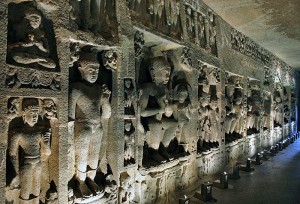 Individual episodes are depicted in the most unexpected manner with respect to each other, the different scenes are not separated by any framework, and they are mutually penetrating. And this chaotic heap of scenes only highlights the variety of the depicted events. Researchers of the murals of Ajanta always pay attention to the realism with which they have depicted life in the palaces, towns and cities in India the middle of I 000 BC, as a result of which the murals of Ajanta has taken the character of the historical document. In a scene of “Buddha is taming a wild elephant” it can be seen how the ancient commercial street in Old town looked like: shops with goods, utensils, carts, canvas awnings on bamboo poles, protecting the stall against the sun. And with astonishing skill it was depicted the elephant that frightened people and the crowds running away in panic and trying to hide. And after all probably such scene were really played out in the Indian market …
Individual episodes are depicted in the most unexpected manner with respect to each other, the different scenes are not separated by any framework, and they are mutually penetrating. And this chaotic heap of scenes only highlights the variety of the depicted events. Researchers of the murals of Ajanta always pay attention to the realism with which they have depicted life in the palaces, towns and cities in India the middle of I 000 BC, as a result of which the murals of Ajanta has taken the character of the historical document. In a scene of “Buddha is taming a wild elephant” it can be seen how the ancient commercial street in Old town looked like: shops with goods, utensils, carts, canvas awnings on bamboo poles, protecting the stall against the sun. And with astonishing skill it was depicted the elephant that frightened people and the crowds running away in panic and trying to hide. And after all probably such scene were really played out in the Indian market …
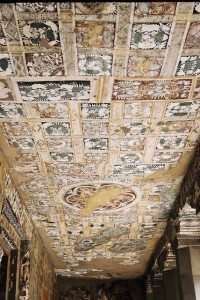 The paintings of Ajanta have naturally used the stone sculptures and reliefs. With special art it was decorated the main entrance to one of the underground churches. Above the entrance the ancient masters depicted eight figures of Buddha in pink and white clothes on a black background. Under them there are eight images of happy couples. These images have been spread all over the world and they are likely to be found in any edition devoted to the ancient Indian art. Along the both sides of the entrance inside the dim niches there are the monumental sculptures of the goddess of the sacred rivers of Gang and Yamuna. One of the goddesses is standing on a stone turtle, the other – on a crocodile. Niches with statues are surrounded by a picturesque images of dick vegetation. Ceiling paintings of Ajanta cave temples were designed to destroy the rock pressure and to lift the headroom. This is achieved by a surprising variety of ornaments that were painted on the ceilings. The ornament consists of flowers, leaves, fruits, combined with images of birds and animals. All of them were involved into the unique group. In some cases, artists tried to make the character of caisson ceiling, with ornamentation visually increasing the height of the cave arches.
The paintings of Ajanta have naturally used the stone sculptures and reliefs. With special art it was decorated the main entrance to one of the underground churches. Above the entrance the ancient masters depicted eight figures of Buddha in pink and white clothes on a black background. Under them there are eight images of happy couples. These images have been spread all over the world and they are likely to be found in any edition devoted to the ancient Indian art. Along the both sides of the entrance inside the dim niches there are the monumental sculptures of the goddess of the sacred rivers of Gang and Yamuna. One of the goddesses is standing on a stone turtle, the other – on a crocodile. Niches with statues are surrounded by a picturesque images of dick vegetation. Ceiling paintings of Ajanta cave temples were designed to destroy the rock pressure and to lift the headroom. This is achieved by a surprising variety of ornaments that were painted on the ceilings. The ornament consists of flowers, leaves, fruits, combined with images of birds and animals. All of them were involved into the unique group. In some cases, artists tried to make the character of caisson ceiling, with ornamentation visually increasing the height of the cave arches.
 Fabulously rich and varied world of Ajanta murals became known to the world only after 1819, when the long-forgotten cave temples of Ajanta were discovered by chance. In the 1920s, paintings in the caves were carefully restored and since then they have been secured. “The scenic design of the cave temples of Ajanta is in line with the best monuments of ancient Indian art and culture. Being the top of fine art of the Gupta period, the murals of Ajanta influenced the development of painting in almost all parts of medieval Asia. They were a true school for the whole generations of foreign masters. But first of all, these paintings provided a solid basis for the development of Indian traditions of fine art.
Fabulously rich and varied world of Ajanta murals became known to the world only after 1819, when the long-forgotten cave temples of Ajanta were discovered by chance. In the 1920s, paintings in the caves were carefully restored and since then they have been secured. “The scenic design of the cave temples of Ajanta is in line with the best monuments of ancient Indian art and culture. Being the top of fine art of the Gupta period, the murals of Ajanta influenced the development of painting in almost all parts of medieval Asia. They were a true school for the whole generations of foreign masters. But first of all, these paintings provided a solid basis for the development of Indian traditions of fine art.